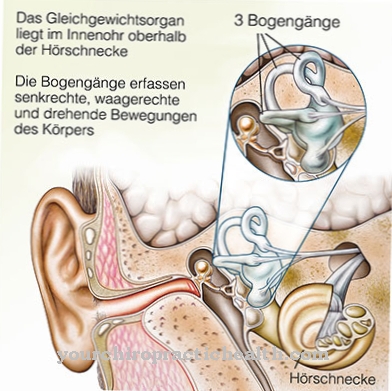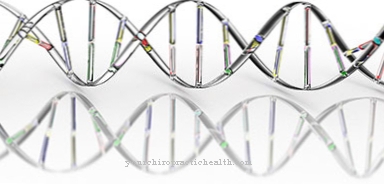Insertion tendopathies are painful conditions caused by irritation of the tendon insertions in the transition from the tendon to the bone. In particular, athletes are affected by insertion tendinopathies.
What is Insertional Tendopathy?

© Venus - stock.adobe.com
As Insertion tendopathies In summary, inflammation or irritation in the tendon attachment area, i.e. in the transition zone from the tendon to the bone.
Depending on the clinical symptoms, a distinction is made between chronic and acute insertion tendinopathies. While in acute insertion tendopathies the pain symptoms as a result of trauma are in the foreground, chronic irritation of the tendon insertions in many cases leads to structural-degenerative changes such as calcium deposits, bone spur formation or ossification in the affected areas.
Pronounced pain in the area of the tendon insertion, which increases with passive stretching and active tension under resistance, are characteristic symptoms of insertion tendinopathy. In general, an insertion tendon can manifest itself at all tendon attachments, among others the Achilles tendon (Achillodynia), the patellar tendon (patellar tip syndrome), the supraspinatus tendon (supraspinatus tendon syndrome) and the tendon attachments of the elbow (tennis elbow).
causes
Generally, between a primary Insertional tendopathywhich is directly caused by sport-specific overload, and the secondary insertion tendopathy, which can occur in connection with muscular tension as a result of arthrosis or vertebral diseases (originating from the spine).
Especially in athletes and untrained people, the tendon insertions are heavily strained during peak loads. Unilateral loads, incorrect movements and external factors (including very hard flooring, exposure to cold) can cause incorrect loading of the insertion areas, which on the one hand ensure the transmission of force from the tendon to the bone and on the other hand cushion excessive loads.
In addition, deformities affecting the joints or bone axes can lead to permanent mechanical irritation of the tendons (microtraumas). As a result of the pain-related permanent relief of the affected area, the adjacent muscles can also atrophy. Inflammatory (e.g. rheumatism, Bechterew's disease) or metabolic diseases can also promote the development of insertion tendinopathy.
Symptoms, ailments & signs
Insertion tendopathy manifests itself primarily as increasing pain in the affected part of the body. The symptoms mainly occur during physical activity and cause tension and muscle hardening as they progress. The pain can also lead to permanent muscle weakness.
Atrophy can also occur. Externally, the insertion tendon can be recognized by the noticeable swelling or thickening of the tendon. The affected body region may be red and overheated. The symptoms mainly occur at the tendon attachments of the elbow as well as in the area of the Achilles tendon and patellar tendon.
After a sports injury, painful inflammation or irritation can also occur in the pelvic area. The pain itself can occur during exercise and at rest. Typically, the inflammation is most noticeable at night. Then there is severe pain, which leads to sleep problems, depression and other complications in those affected.
As a result, those affected are often irritable and occasionally suffer from depressive moods. The relieving posture can lead to joint wear, permanent misalignments, circulatory disorders and a number of other symptoms and complaints. Children may even experience developmental disorders or permanent muscle weakness.
Diagnosis & course
In many cases the suspicion arises of one Insertional tendopathy from the clinical symptoms as well as the sport-specific stresses described by the person concerned in the context of the anamnesis.
A radiological examination can reveal the loosened areas in the bony area of the insertion sites, which are characteristic of chronic insertion tendinopathy, as well as the structural changes, whereby in some cases an assessment comparing with the opposite side can be useful. Magnetic resonance imaging (MRI) can be used to assess bone changes and the typical thickening and swelling of the tendons in the insertion area (edematous and fatty degeneration).
In addition, the end points of the tendons usually have fibrous roughening. The prognosis and course of insertion tendinopathies depend to a large extent on the specifically affected tendon attachment and the compliance (cooperation with regard to therapy) of the person affected, but can generally be rated as good.
Complications
In most cases, insertion tendinopathy occurs primarily in athletes. This leads to pain and inflammation of the tendons, which usually results in severe restrictions on movement. The patient's quality of life is reduced by this disease. It is not uncommon for pain in the muscles to occur, which leads to a reduced resilience of the person concerned.
Likewise, the movement restrictions can be so pronounced that the person affected is dependent on the help of other people in everyday life. Without treatment, the insertion tendinopathy leads to muscle weakness. The everyday life of the person affected is significantly restricted by this disease. It is not uncommon for the affected regions to swell. If there is rest pain, this rest pain can also lead to sleep problems or depression.
Treatment is carried out with the help of drugs or therapies. There are no particular complications. However, the pain and discomfort may not be completely relieved. The life expectancy is usually not reduced or influenced by the insertion tendinopathy. As a rule, certain sports can no longer be carried out easily.
When should you go to the doctor?
If pressure pain, muscle tension or stress pain is noticed at the tendon insertion, a doctor or sports medicine specialist should be consulted as soon as possible. A medical examination is necessary if the symptoms persist for more than a few days or if they rapidly increase in intensity. If the symptoms occur in connection with an injury, you should see a doctor immediately. Medical advice is particularly important in the case of externally visible symptoms, such as reddening or even bleeding. If a hardening of the muscles is noticed, the disease may have progressed further.
A doctor must diagnose insertional tendinopathy before tendon thickening or other serious complications develop. Athletes and people who subject their feet to great stress at work are particularly prone to the disease and should see a doctor if the symptoms mentioned. The right contact person is the family doctor, a sports doctor or an orthopedist. If the affected foot can no longer be moved at all, it is best to go to the nearest hospital. Ideally, the insertion tendinopathy is treated in a specialist clinic. Children should be taken to a pediatrician if there are signs of tendon disease.
Treatment & Therapy
The therapeutic measures depend significantly on the severity of the pain symptoms and on whether there is an acute or chronic inflammation of the tendon insertion. In an acute one Insertional tendopathy For example, the treatment measures initially aim at immobilizing the affected area.
Cryotherapeutic measures (e.g. with CO2 or ice) as well as orally or locally applied anti-inflammatory drugs (anti-inflammatory drugs) can be used as support. After the acute pain symptoms have subsided, electrotherapeutic and physical measures (including TENS, ultrasound therapy, iontophoresis) are usually indicated. In the case of chronic insertion tendinopathies, isometric contraction exercises are usually recommended initially to strengthen the muscles, which are replaced in the later course of therapy by dynamic exercises below the pain threshold.
In addition, corticosteroid infiltrates, local heat applications and extracorporeal shock wave therapy (ESWT) can be used to relieve pain and ensure elasticity. In addition, the underlying cause of the insertion tendinopathy should be treated or eliminated. If, for example, the Achilles tendon attachment (achillodynia) is affected, footwear with slightly raised heels can help in some cases.
Furthermore, in the case of chronic insertion tendinopathies, in particular on the Achilles tendons, elbows or in the shoulder area, therapy with ACP (autologous conditioned plasma) can be considered to stimulate regenerative growth and accelerate healing. Surgical removal of the affected part of the tendon is seen as the last resort in the case of insertion tendinopathies and, due to the risk of functional impairment, is only considered if the treatment is not successful due to conservative measures.
Outlook & forecast
As a rule, insertion tendinopathy must always be treated by a doctor. If the disease is not treated, the pain will not go away on its own and in most cases the symptoms will worsen significantly.
As a rule, the severe pain of insertion tendinopathy can be treated well with the help of pain relievers. There are no further complications or other complaints. Furthermore, the pain can be relieved with the help of various therapies and exercises. This also alleviates the further course of the disease and limits the symptoms. Correct treatment of insertion tendinopathy also leads to a positive course of the disease in most cases, although a complete cure cannot always be achieved.
If the insertion tendinopathy is not treated, there will be considerable complications and restrictions in the everyday life of the person concerned. The patient suffers from severe restrictions on movement and can usually no longer cope with everyday life alone. He is dependent on the help of other people and suffers from a significantly reduced quality of life. The life expectancy is usually not negatively influenced by the insertion tendinopathy.
prevention
Sport-specific overloads and thus also Insertion tendopathies can be circumvented through adequate training programs tailored to individual needs. Untrained people should also avoid excessive strain during sporting activities. In addition, well-built muscles protect against overuse of the tendons and reduce the risk of insertion tendinopathies.
Aftercare
As a rule, the patient with an insertion tendinopathy has very few or even no special follow-up measures available. In the case of this disease, the person affected is primarily dependent on a quick diagnosis and also on quick and above all on early treatment of the disease so that further complications can be prevented.
Insertion tendopathy cannot heal itself, so that those affected are always dependent on treatment by a doctor. As a rule, the treatment is carried out by taking medication. Those affected should always ensure that the medication is taken regularly and that the dosage is correct in order to permanently alleviate the symptoms.
In many cases, concentration exercises are also necessary to control the symptoms of insertion tendinopathy. Many of the exercises can also be done in your own home, which may speed up healing. Most patients with this disease are also dependent on the help and support of their own family and friends, although loving and intensive discussions may be necessary in order to prevent psychological upsets or depression.
You can do that yourself
The treatment of insertion tendinopathy usually depends on the exact cause. However, the affected person must in any case immobilize the affected region and protect it and not move it anymore. Athletes in particular should no longer pursue their sport if they have insertion tendinopathy.
To strengthen the muscles, the patient has various exercises available that can be performed in physiotherapy or at home. Above all, contraction exercises have a positive effect on the course of the disease. This also allows the region to regain mobility so that there are no restrictions in everyday life. The application of heat is also very helpful for insertion tendinopathy. These include hot baths or a visit to a sauna.
If the complaints arise in the Achilles tendon, special shoes can be helpful here. These should have a slight heel and be a bit wider than normal footwear to support the leg when running. The person affected should also regularly apply the prescribed medication to the respective area for pain relief, as this also prevents further inflammation and treats the current ones.




.jpg)
.jpg)


















.jpg)



